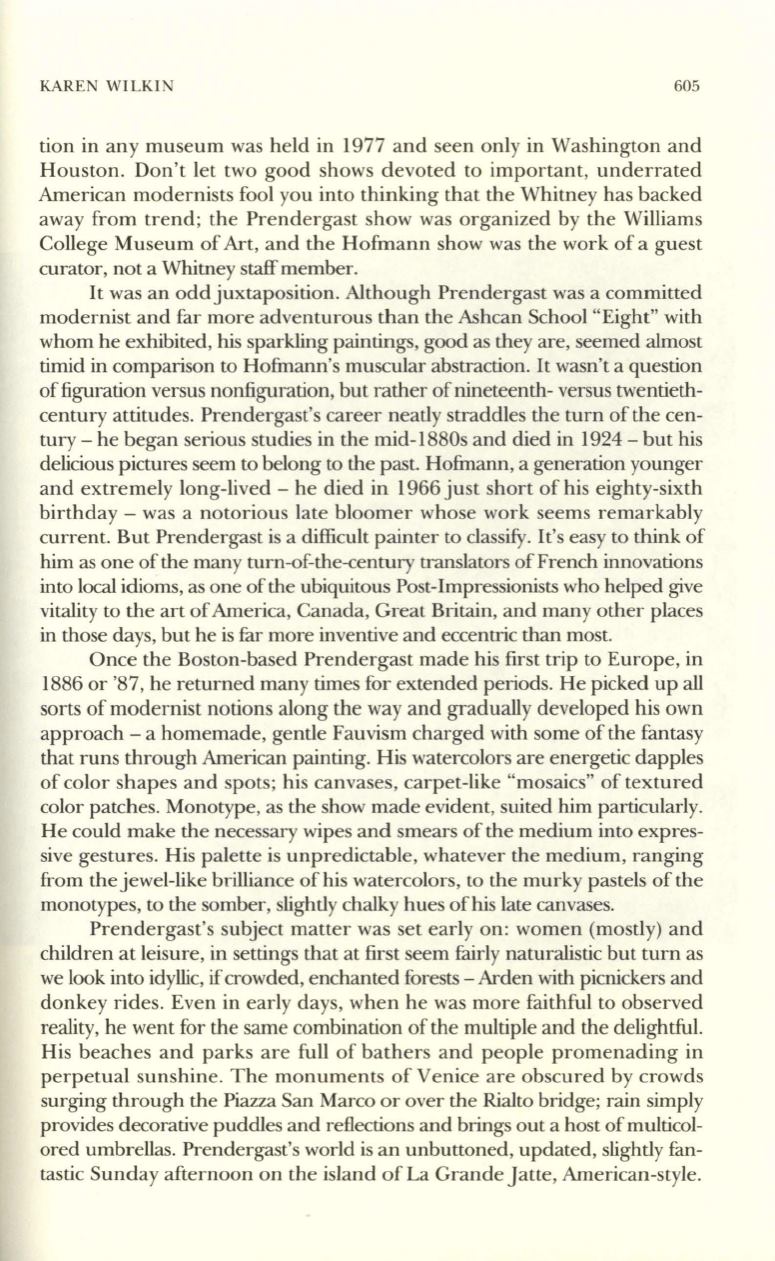
KAREN WILKIN
605
tion in any museum was held in 1977 and seen only in Washington and
Houston. Don't let two good shows devoted to important, underrated
American modernists fool you into thinking that the Whitney has backed
away from trend; the Prendergast show was organized by the Williams
College Museum of Art, and the Hofmann show was the work of a guest
curator, not a Whitney staff member.
It was an odd juxtaposition. Although Prendergast was a committed
modernist and far more adventurous than the Ashcan School "Eight" with
whom he exhibited, his sparkling paintings, good as they are, seemed almost
timid in comparison to Hofmann's muscular abstraction. It wasn't a question
of figuration versus nonfiguration, but rather of nineteenth- versus twentieth–
century attitudes. Prendergast's career neatly straddles the turn of the cen–
tury - he began serious studies in the mid-1880s and died in 1924 - but his
delicious pictures seem to belong to the past. Hofmann, a generation younger
and extremely long-lived - he died in 1966 just short of his eighty-sixth
birthday - was a notorious late bloomer whose work seems remarkably
current. But Prendergast is a difficult painter to classify. It's easy to think of
him as one of the many turn-of-the-century translators of French innovations
into local idioms, as one of the ubiquitous Post-Impressionists who helped give
vitality to the art ofAmerica, Canada, Great Britain, and many other places
in those days, but he is far more inventive and eccentric than most.
Once the Boston-based Prendergast made his first trip to Europe, in
1886 or '87, he returned many times for extended periods. He picked up all
sorts of modernist notions along the way and gradually developed his own
approach - a homemade, gentle Fauvism charged with some of the fantasy
that runs through American painting. His watercolors are energetic dapples
of color shapes and spots; his canvases, carpet-like "mosaics" of textured
color patches. Monotype, as the show made evident, suited him particularly.
He could make the necessary wipes and smears of the medium into expres–
sive gestures. His palette is unpredictable, whatever the medium, ranging
from the jewel-like brilliance of his watercolors, to the murky pastels of the
monotypes, to the somber, slightly chalky hues of his late canvases.
Prendergast's subject matter was set early on : women (mostly) and
children at leisure, in settings that at first seem fairly naturalistic but turn as
we look into idyllic,
if
crowded, enchanted forests - Arden with picnickers and
donkey rides. Even in early days, when he was more faithful to observed
reality, he went for the same combination of the multiple and the delightful.
His beaches and parks are full of bathers and people promenading in
perpetual sunshine. The monuments of Venice are obscured by crowds
surging through the Piazza San Marco or over the Rialto bridge; rain simply
provides decorative puddles and reflections and brings out a host ofmulticol–
ored umbrellas. Prendergast's world is an unbuttoned, updated, slightly fan–
tastic Sunday afternoon on the island of La Grande Jatte, American-style.


